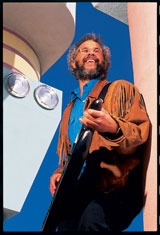|
|
A Knave Judges a King |
June 1998 |
|
Uneasy lies the mic that wears the crown.
As Larry the O pointed out in last month's "Final Mix" column, speakers and microphones are the only devices in the studio that deal with sound. All the rest’Äîmixers, signal processors, synths, recording devices, and so on’Äîdeal with electrons and/or bits. If you want to capture sound, you need a mic.
When top-flight audio quality is paramount, engineers generally turn to condenser mics. There's no doubt these devices capture sound with more accuracy than dynamics. In the past, however, condensers were prohibitively expensive and somewhat fragile, so dynamic mics were the usual choice of stage musicians and home recordists.
Today, condenser mics have come way down in price, and most are fairly sturdy. However, dynamic mics are also better than ever, and they still offer many of the same advantages they always have: they're less expensive and tougher. Furthermore, the sound quality of many modern dynamic mics is impressive.
Can dynamic mics really take more stress than condensers? You bet! When I interviewed pioneer electronic musician and bioacoustician Bernie Krause for a story in the May 1989 EM ("Making Music with Nature: Bernie Krause Samples Life"), he related the following story.
Krause generally preferred condenser mics when recording natural sounds in the field. So when planning a trip to record mountain gorillas in Rwanda's rainforests for his album Gorillas in the Mix, he first considered using his beloved Schoeps 541 hypercardioid condensers. Concerned about the high Rwandan humidity, he decided to test the Schoeps in a steam-filled bathroom. The condenser mics failed within three minutes! So Krause opted for a pair of Beyerdynamic M700N(C) hypercardioid dynamics, which not only handled the steam test but easily survived three to four hours of sitting in the rain.
Krause mounted the mics atop his head with an elaborate rig so that the wires wouldn't entangle his body. At one point, he had to dive headfirst into the underbrush to evade a charging gorilla; the mics took the full impact and never failed. As Krause remarked, "That's a rock 'n' roll mic; it takes a lot more than a gorilla to destroy them."
Obviously, then, dynamic mics are more likely than condenser mics to survive the punishment meted out by the stage gorillas one sometimes encounters on tour. This is not to say one shouldn't take condensers on tour; just that when push comes to shove, the lower-cost dynamic can take a lot more pushing and shoving.
In this issue's cover story ("Is the SM58 Still King?" on p. 34), Associate Editor Brian Knave field-tests seven recent-vintage, low-cost dynamic mics and compares them to Shure's SM58, the acknowledged best-selling "king" of handheld dynamics. He didn't test higher-priced dynamics because we wanted to find out what you could buy for $100 to $200, the traditional realm of the SM58. Although Knave didn't face a charging gorilla, he displayed courage in undertaking the daunting task of comparing these mics. You could say that EM's "Knave of Arts" judged a king and lived to tell about it. |
